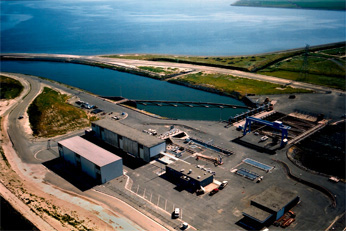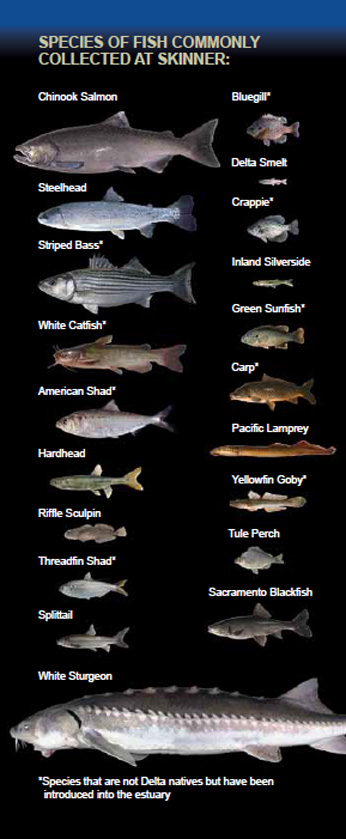What is the Delta Fish Agreement?
 Skinner Fish Facility diverts some fish from the Harvey O. Banks Delta Pumping Plant. CDWR Photo.
Skinner Fish Facility diverts some fish from the Harvey O. Banks Delta Pumping Plant. CDWR Photo.
On December 30, 1986, the Directors of CDFW and the Department of Water Resources (DWR) signed an agreement to provide for offsetting fishery impacts caused by the diversion of water at the Harvey O. Banks Delta Pumping Plant (Banks), located at the head of the California Aqueduct near Tracy, California. The agreement, currently referred to as the Delta Fish Agreement (DFA or Agreement) (PDF), was previously known as the Delta Pumping Plant Fish Protection Agreement or Four Pumps Agreement because it was adopted as part of the mitigation package to add four additional pumps to Banks during the late 1980’s. Direct losses of Chinook salmon, steelhead, and striped bass are offset or mitigated through the funding and implementation of fish mitigation projects.
Among its provisions, the agreement provides funding to estimate the annual fish losses at Banks and a process to mitigate those accumulated direct fish losses. The annual fish losses are tabulated as yearling fish species to be offset through the implementation of fish restoration projects or actions which would be paid for by DWR from State Water Project Funds. Since the implementation of the DFA, mitigation for the tabulated direct losses for the initial fish species of concern (Chinook salmon, steelhead, and striped bass) have been offset almost 100% by the fish credit benefits produced by the fish mitigation actions which have been determined to benefit those fish species. Mitigation is on a fish-for-fish basis and both the fish losses and the fish credits are statistical estimates based on real-time sample variables collected annually and should be viewed as a relative estimation of fish benefits produced.
CDFW's Role in the Delta Fish Agreement
CDFW and DWR work closely with the Fish Advisory Committee to implement the agreement and projects funded under the agreement. The Fish Advisory Committee is made up of representatives of the State Water Contractors, sport and commercial fishing groups, and environmental groups. The process of mitigation is accomplished by implementing habitat restoration actions which will produce fish credits to offset the tabulated losses which have occurred at Banks. Restoration projects which meet the metric need to produce fish credits are identified from various environmental planning sources. These projects are developed through transparent technical discussions amongst interest groups and are peer reviewed for fishery benefits. The number of fish credits produced by a project is described in the project proposal which is developed by CDFW. Projects that meet the necessary criteria for fish benefit and credit are brought forward by CDFW to a DFA Advisory Committee made up of nine members jointly chosen by the Directors of CDFW and DWR. The membership represents State Water Contractors, fishing and environmental organizations. The role of the DFA Advisory Committee is to provide stakeholder review comment and approval recommendation of the CDFW/DWR Directors.
Delta Fish Agreement Amendment to Address Listed Species and Indirect Loss
 Fish species commonly collected at the Skinner Fish Facility. CDWR Photo.
Fish species commonly collected at the Skinner Fish Facility. CDWR Photo.
In February 2006, the Directors of DWR and CDFW agreed to direct staff to begin discussions to amend the 1986 Delta Fish Agreement (DFA) to develop additional measures to mitigate impacts caused by the State Water Project (SWP) operations in the Delta. These measures were intended to be part of a long term solution to Delta problems. The primary objective of the Amendment was to mitigate for the take of delta smelt, longfin smelt, winter-run Chinook salmon, and spring-run Chinook salmon at the SWP Delta Pumping Plant. Authority to amend the 1986 DFA is contained in two sections of the original agreement:
- Article V, Paragraph B which states measures to offset direct losses for fish species not targeted by the original DFA shall be included when more information is obtained to develop effective measures, and provides for the addition of other species to the DFA.
- Article VII of the DFA directs CDFW and DWR to develop ways to offset the adverse impacts of the SWP to fish species not addressed in the DFA, and provides for the resolution of indirect impacts to fish species through the existing DFA.
Almost five years of CDFW/DWR negotiations transpired before an acceptable agreement was achieved for a DFA Amendment that would address California Endangered Species Act (CESA) mitigation requirements for the SWP Delta pumping operations. One of the major elements of the Amendment was a methodology which quantified the water surface area of the Sacramento-San Joaquin estuary (Delta) habitat impacted by the SWP and Federal Central Valley Project (CVP), operations at various pumping rates described as Export to Import (E:I) ratios. The methodology uses an analysis based on the particle tracking model runs described in Kimmerer and Nobriga 2008, occurring at various E:I ratios. This analysis describes the general loss of "neutrally buoyant particles" to the Delta export pumps which is then converted into the amount of surface area impacted by those exports, measured in acres, and interpreted to imply the overall effect of pumping operations to the aquatic environment. This metric is inferred by CDFW to be a surrogate for lost primary productivity and the fish life stages vulnerable to those pump related effects for important native fish such as winter/spring-run Chinook salmon and delta/longfin smelt. This metric was agreed to by CDFW and DWR to represent a quantification of the indirect loss impacts due to SWP/CVP pumping operations. This methodology was called the "CDFW Rationale for Effects of Exports" (CDFW Rationale) and the basic assumptions of the Rationale are:
- Intertidal restoration acreage represents the area of aquatic habitat for covered species in the Delta indirectly impacted by operation of the SWP/CVP. This acreage also accounts for habitat degradation due to the loss of nutrients, primary production, and secondary production within the water column.
- Acreage represents the overall effect to the Delta due to SWP and CVP pumping during 2001-2006.
- Using the actual amount of water exported, the responsibility of impact can be apportioned between the State and Federal water projects at the rate of SWP=55% and CVP=45%
- The CDFW Rationale methodology used to determine the mitigation restoration acreage target is based on particle tracking studies using the DSM2-Particle Tracking Model at an E:I ratio of 0.35. The 0.35 E:I ratio was chosen because it was the maximum winter-spring export ratio allowed by current regulations. This ratio yielded a total impact to 21,885 acres
Learn more in CDFW Rationale for Effects of Exports (PDF)
Simultaneous to the CDFW/DWR DFA Amendment discussions in 2008, the U.S. Bureau of Reclamation (Reclamation) was in the process of updating the Continued Long-Term Operations of the CVP and SWP. Both water projects operate pursuant to water right permits and licenses issued by the State Water Resources Control Board (State Water Board) which requires the CVP and SWP to meet specific water quality, quantity, and operational criteria within the Delta as well as meet the State and Federal Endangered Species Act (CESA and ESA). To initiate formal consultation pursuant to Section 7 of the ESA, USBR, with DWR assistance, produced a "Biological Assessment of the Continued Long-term Operation of the CVP and SWP" (BA). The DFA, specific DFA projects, and the CDFW Rationale are all referenced in Appendix Y (PDF) of this BA.
Regarding the CVP/SWP operation effect on fish described in the BA, USBR initiated consultation with the U.S. Fish and Wildlife Service (USFWS) for effects on delta smelt and with NOAA’s National Marine Fisheries Service (NMFS) for the effects on salmonids and green sturgeon. In response to the BA, both USFWS and NMFS produced Biological Opinions (BiOps) to accept the BA with specific conditions and requirements. One condition specifically identified in the USFWS BiOp, Reasonable and Prudent Alternative (RPA) 4 requires DWR to implement a program to restore at least 8,000 acres of tidal marsh in the Delta and Suisun Marsh to support delta smelt recovery. This requirement is also referenced in the NMFS BiOp to support salmonids and green sturgeon recovery. The 8,000 acre metric of restored Delta habitat is believed to have been motivated by the "CDFW Rationale for Effects of Exports," mentioned above because the lower range of the apportioned SWP Delta impact, based on a 0.17 E:I ratio, was determined to be approximately 8,000 acres. The 0.17 E:I ratio represented a suggested export value which DWR believed represented the actual water pumped by the SWP during the winter-spring period. If the winter-spring period included the effects of the CVP, the total amount of lost habitat calculated using the "CDFW Rationale for Effects of Exports" model for and E:I water export rate for 0.17 would be approximately 14,583 acres.